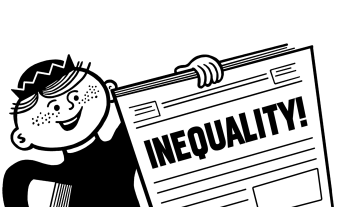
A Piketty guide for lifelong learners.
When Thomas Piketty’s “Capital in the Twenty-first Century” was published earlier this year, it was something of a sensation. That’s no small feat for a chart-heavy doorstop on “the dismal science” of economics.
A fair portion of the book’s notoriety was due to its subject matter: wealth distribution, an intensely political topic if ever there was one. (Watch Piketty’s TED Talk: New thoughts on capital in the twenty-first century.)
What makes this French economist’s conclusions worth global notice? The short answer is that Piketty and his research team amassed a mountain of data, much of it going back centuries, suggesting that the concentration of wealth in ever-fewer hands is not an anomaly or a recent development. Check out the infographic below for a longer explanation:

As the data visualization above suggests, this is simply how capitalism works. Without a significant force to counterbalance rising wealth inequality, the research indicates, a capitalist economy will drift predictably toward oligarchy.
During the last century, however, Piketty shows that a sufficient counterbalance to wealth inequality did emerge. It came in the form of two world wars. The conflicts that engulfed the early twentieth century destroyed capital, rearranged the global balance of power, then ushered in an age of unprecedented growth and technological progress in the developed West. But the underlying structure of the economy, the way fortunes are made and grown, remained largely unchanged since the Industrial Revolution and the Gilded Age.
With the end of World War II now 70 years in the past, it’s easier to view the general prosperity of the mid-20th century in the context of a larger sweep of history. What the data now show is that this period, which has been called “the long peace” and the “Pax Americana,” may not be a validation of western capitalism after all. It may, in fact, be an outlier.
This is why Piketty’s book has ignited such a powerful reaction. If he is right, it would mean that the global economy is accelerating toward a future that’s incompatible with democracy. It would also mean that we’ve been on this course for centuries.
“Capital in the 21st Century” is an effort to demonstrate not only that the data bear out these conclusions, but also to demonstrate the mechanism at work that’s making it happen:
r > g
The mechanism, it turns out, is as simple as three characters.
r > g
This straightforward equation expresses a key phenomenon — that the rate of return on capital (“r”) almost always exceeds the rate of economic growth (“g”).
To understand why this creates and magnifies wealth inequality, let’s first define some terms.
Capital
Capital means different things depending on the context, but here “capital” can simply stand for “wealth” in all its various forms: stocks, real estate, gold, etc.
Rate of return
The rate of return on capital is the change in value of wealth over time. If you buy one share of a company’s stock for $100, and a year later it’s worth $105, you’ve enjoyed a 5% annual rate of return on your purchase.
So, when we say “r > g,” we can understand “r” as the speed at which wealth (capital) increases in value.
Economic growth
Economic growth is the change in value of an economy’s overall productivity. Generally speaking, if an economy produces 5% more (or more-valuable) goods and services this year than last, its growth rate is 5%. If it produces 5% less, its growth rate is -5%.
So, r > g is really just another way of saying this:
Wealth grows faster than the economy.
Piketty’s research shows that the average rate of return on capital has held at around 4% to 5% for most of human history. It rose above 5% during the Industrial Revolution, then fell back below 5% during the middle of the 20th century.
The global economic growth rate, for its part, hovered just above 0% from 1 A.D. until the industrial revolution, when it began to climb toward 2%. Global economic growth spiked to just shy of 4% in the middle of last century, after which it began dropping—slowly at first, then faster—for the first time since the fall of the Roman Empire. And as the gap between r and g widens, the concentration of wealth speeds up.
It’s a bleak picture: Global economic growth is slowing down while wealth inequality is accelerating. Not only that, but the more wealth a person or institution owns, the faster that wealth grows. For instance, from 1987 to 2013, the global rate of return on the wealth owned by the average adult was 2.1%. During that same period, the rate of return on wealth owned by the average billionaire was more than 6.5%.
The results of that difference are pronounced. In the U.S., for example, the richest .1% of American people own almost a quarter of all American wealth. That’s like a four-story hotel with one guy on the top floor and 999 people sharing the other three (800 of whom are on the first floor).
Given all this, democratic ideals like social mobility, the American Dream, and shared prosperity recede from plausibility. The numbers just don’t add up. So the question then becomes whether anything can be done to counterbalance the trend before it becomes too destabilizing.
[ted id=2101]
Featured image via iStock.













